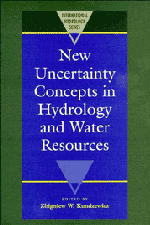Book contents
- Frontmatter
- Contents
- List of Authors
- Preface
- I INTRODUCTION
- II FACETS OF UNCERTAINTY
- III NOVEL APPROACHES TO UNCERTAINTY: FRACTALS, FUZZY SETS AND PATTERN RECOGNITION, NON-PARAMETRIC METHODS
- IV RANDOM FIELDS
- 1 Analysis of regional drought characteristics with empirical orthogonal functions
- 2 Worth of radar data in real-time prediction of mean areal rainfall by nonadvective physically-based models
- 3 Uncertainty analysis in radar-rainfall estimation
- 4 Design of groundwater monitoring networks for landfills
- 5 Spatial variability of evaporation from the land surface – random initial conditions
- 6 Detecting outliers in flood data with geostatistical methods
- V TIME SERIES AND STOCHASTIC PROCESSES
- VI RISK, RELIABILITY AND RELATED CRITERIA
5 - Spatial variability of evaporation from the land surface – random initial conditions
Published online by Cambridge University Press: 07 May 2010
- Frontmatter
- Contents
- List of Authors
- Preface
- I INTRODUCTION
- II FACETS OF UNCERTAINTY
- III NOVEL APPROACHES TO UNCERTAINTY: FRACTALS, FUZZY SETS AND PATTERN RECOGNITION, NON-PARAMETRIC METHODS
- IV RANDOM FIELDS
- 1 Analysis of regional drought characteristics with empirical orthogonal functions
- 2 Worth of radar data in real-time prediction of mean areal rainfall by nonadvective physically-based models
- 3 Uncertainty analysis in radar-rainfall estimation
- 4 Design of groundwater monitoring networks for landfills
- 5 Spatial variability of evaporation from the land surface – random initial conditions
- 6 Detecting outliers in flood data with geostatistical methods
- V TIME SERIES AND STOCHASTIC PROCESSES
- VI RISK, RELIABILITY AND RELATED CRITERIA
Summary
ABSTRACT The effect of spatial variation of the initial moisture contents on the distribution of soil moisture and the evaporation rate from the land surface is evaluated. The process of drying is described by a lumped, nonlinear model representing two stages of evaporation using the thermodynamic equation.
STAGES OF SOIL DRYING
The evapotranspiration process over the catchment considered in this work, can be subdivided into two stages. If there is enough water at the surface of the soil, the evapotranspiration proceeds at the potential rate and the process is determined by the atmospheric conditions above the soil surface and the evapotranspiration rate does not depend on the state of the soil. Once the soil moisture at the surface layer is below some value prescribed by soil and vegetation conditions, it is these conditions, that control the evapotranspiration rate, independently of the atmospheric conditions. The controlling factor is usually taken as a threshold average root zone water contents below which the transport of water to the plant leaves limits the transpiration process (Gardner et al., 1975; Cordova & Bras, 1981). In the literature, these two stages of evapotranspiration were tackled using switching boundary conditions (e.g. Entekhabi & Eagleson, 1989; and Kuhnel, 1989). In the first stage the condition of constant moisture flux at the surface was used and in the second stage this condition was replaced by the condition of the constant moisture contents at the surface.
- Type
- Chapter
- Information
- New Uncertainty Concepts in Hydrology and Water Resources , pp. 197 - 205Publisher: Cambridge University PressPrint publication year: 1995
- 2
- Cited by



